
NGC 7012 is a large, bright elliptical galaxy located about 380 million light-years away from Earth in the constellation Microscopium. NGC 7012 was discovered by astronomer John Herschel on July 1, 1834.

NGC 4612 is a barred lenticular galaxy located about 57 million light-years away in the constellation of Virgo. NGC 4612 was discovered by astronomer William Herschel on January 23, 1784. The galaxy is a member of the Virgo Cluster.

NGC 4907 is a barred spiral galaxy located about 270 million light-years away in the constellation of Coma Berenices. It is also classified as a LINER galaxy. NGC 4907 was discovered by astronomer Heinrich d'Arrest on May 5, 1864. The galaxy is a member of the Coma Cluster, located equidistant between NGC 4928 and NGC 4829.

NGC 4492 is a spiral galaxy located about 90 million light-years away in the constellation Virgo. NGC 4492 was discovered by astronomer William Herschel on December 28, 1785. It was rediscovered by astronomer Arnold Schwassmann on January 23, 1900, and was listed as IC 3438. NGC 4492 lies in the direction of the Virgo Cluster. However, it is not considered to be a member of that cluster.

NGC 1955 is an open cluster associated with an emission nebula located in the Dorado constellation. This nebula is part of the H II region which is part of the Large Magellanic Cloud and was discovered by James Dunlop on August 3, 1826. Its apparent magnitude is 9.0, and its size is 1.8 arc minutes.

NGC 1959 is an open cluster located in the Mensa constellation which is part of the Large Magellanic Cloud. It was discovered by John Herschel on December 23, 1834. Its apparent magnitude is 12.2, and its size is 0.50 arc minutes.

NGC 4498 is a barred spiral galaxy located about 50 million light-years away in the constellation Coma Berenices. NGC 4498 was discovered by astronomer William Herschel on March 21, 1784. NGC 4498 is a member of the Virgo Cluster.
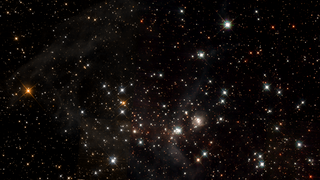
NGC 1974 is an open cluster associated with an emission nebula which is located in the Dorado constellation which is part of the Large Magellanic Cloud. It was discovered by James Dunlop on November 6, 1826, and later observed by John Herschel on January 2, 1837, subsequently cataloged as NGC 1991. Its apparent magnitude is 9.0 and its size is 1.7 arc minutes.
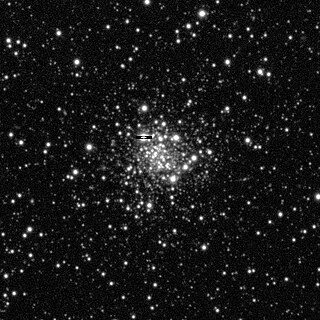
NGC 1997 is an open cluster located in the Dorado constellation which is part of the Large Magellanic Cloud. It was discovered by John Herschel on November 30, 1834. Its apparent magnitude is 13.43 and its size is 1.80 arc minutes.
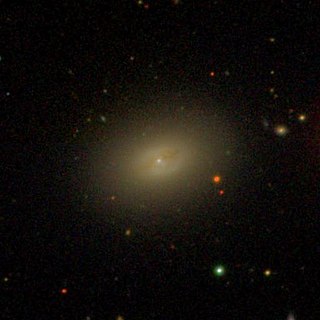
NGC 4506 is a spiral galaxy located around 50 million light-years away in the constellation Coma Berenices. It is classified as peculiar due to the presence of dust that surrounds its nucleus. NGC 4506 was discovered by astronomer William Herschel on January 14, 1787. It is a member of the Virgo Cluster.
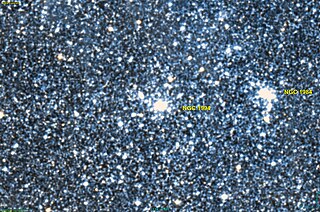
NGC 1994 is an open cluster in the Dorado constellation which is located in the Large Magellanic Cloud. It was discovered by John Herschel on 16 December 1835. It has an apparent magnitude of 9.8 and its size is 0.60 arc minutes.
NGC 1986 is an open cluster which is located in the Mensa constellation which is part of the Large Magellanic Cloud. It was discovered by James Dunlop on September 27, 1826. It has an apparent magnitude of 11.31 and its size is 2.80 by 2.40 arc minutes.

NGC 1983 is an open cluster associated with an emission nebula which is located in the Dorado constellation and part of the Large Magellanic Cloud. It was discovered by John Herschel on 11 November 1836. It has an apparent magnitude of 9.9 and its size is 1.0 arc minutes.
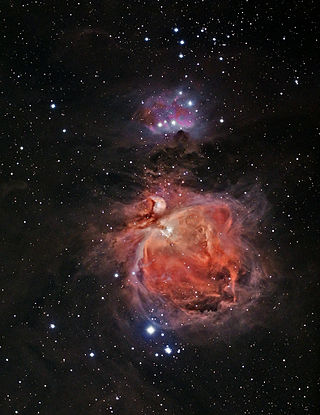
NGC 1981 is an open cluster which is located in the constellation Orion. It was discovered by John Herschel on 4 January 1827. Its apparent magnitude is 4.2 and its size is 28.00 arc minutes. It lies to the north of the Orion Nebula, separated from it by the Sh2-279 region containing NGC 1973, 1975, and 1977.
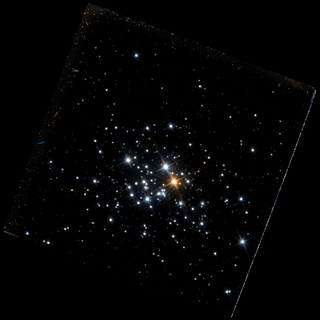
NGC 1984 is an open cluster associated with an emission nebula, it is located in the constellation Dorado in the Large Magellanic Cloud. It was discovered by John Herschel on 16 December 1835. The apparent magnitude is 9.9 and its size is 1.50 by 1.20 arc minutes.

NGC 1436 is a barred spiral galaxy approximately 58 million light-years away from Earth in the constellation of Eridanus. It is a member of the Fornax I cluster.

NGC 521, also occasionally referred to as PGC 5190 or UGC 962, is a barred spiral galaxy located approximately 224 million light-years from the Solar System in the constellation Cetus. It was discovered on 8 October 1785 by astronomer William Herschel.
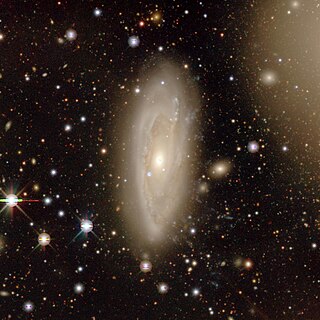
NGC 3312 is a large and highly inclined spiral galaxy located about 194 million light-years away in the constellation Hydra. The galaxy was discovered by astronomer John Herschel on March 26, 1835. It was later rediscovered by astronomer Guillaume Bigourdan on February 26, 1887. NGC 3312 was later listed and equated with IC 629 because the two objects share essentially the same celestial coordinates. NGC 3312 is the largest spiral galaxy in the Hydra Cluster and is also classified as a LINER galaxy.
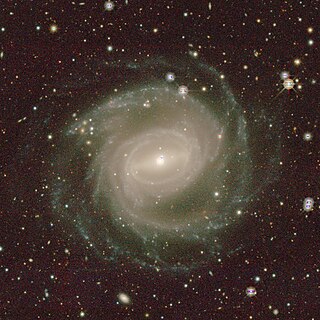
NGC 3313 is a large barred spiral galaxy located about 55 megaparsecs away in the constellation Hydra. It was discovered by astronomer Ormond Stone in 1886 and is an outlying member of the Hydra Cluster.


















